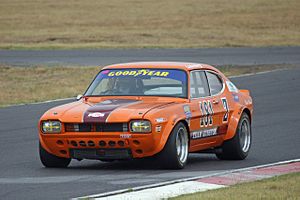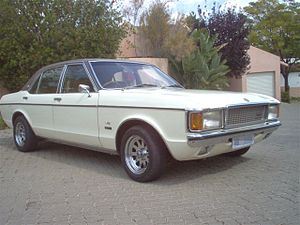Basil Green Motors
Basil Green Motors , abbreviated to BG in the vehicle identification number , is a former rally team and also operated as an automobile tuner and manufacturer . The company's headquarters were in Johannesburg , South Africa . The company specialized in vehicles of the Ford brand , whereby the models of the manufacturer can be recognized by the brand name Perana attached to the model name . The name Perana is a deliberate misspelling, as piranha was already protected. The company currently still exists, but only acts as an authorized dealer for Ford and Mazda .
The company founded by Basil Green in 1967 dealt in its early days with the engine tuning of Ford brand vehicles and also participated as a rally team in a large number of races. With the achievement of several profits, the Ford Motor Company became aware of the company and used the company as a kind of in-house tuner for some of the South African models.
Cortina Mk II
| Gunston Cortina | |
|---|---|

|
|
| Engine: | Ford Essex 3 liter |
The manufacturer's first model was the Ford Cortina Perana V6 , which was launched as a tuning model in 1967. However, series production did not begin until a year later in the summer. Grosvenor Motors , the largest Ford dealer in South Africa at the time, was responsible for sales . The price was 2950 rand . The standard version was based on the Ford Cortina Mk II GT. For the units ordered by the Gunston Cigarette Company, however, the Ford Cortina XL was used as the basis. As a motorization was V6 engine of the type Ford Essex used having a capacity possessed of 2994 cm³. Like the drive train, this was taken over from the Ford Zephyr . After the entire conversion and lowering, the Cortina Perana V6 was 64 kg heavier than the standard Ford model. The distinguishing features of the Cortina Perana V6 are, on the one hand, the black horizontal stripes over the bonnet , as well as a black front grille and black colored rims.
Escort Mk I
| Escort Perana | |
|---|---|

|
|
| Engine: | Pinto 2 liters |
| Number of pieces: | about 100 |
The second model of the manufacturer from 1968 was the Ford Escort Perana sports car . Ford actually wanted to use the RS 1600 for this, but the Cosworth BDA engine turned out to be too complex for South Africa. Basil Green Motors made new plans and fitted the four-cylinder 2-liter engine from the compact Ford Pinto .
Basil Green sold the removed RS 1600 engines for 695 rand as ideal for, among other things, the escort.
Capri Mk I.
| Capri Perana V8 | |
|---|---|

|
|
| Engine: | Windsor V8 302 cui |
| Power: | 240 hp (179 kW) |
| Acceleration: | 0 to 100 km / h in 6.7 seconds |
| Top speed: | 228.4 km / h |
The third model, the Ford Capri Perana , came out in 1969 in a V6 version. About 20 units of this model were built. The top speed was 186 km / h. Since Ford offered the Essex V6 as standard for the Capri from 1970, a more powerful engine was needed for Basil Green, and so the V6 was replaced by Ford Windsor V8s from the Ford Mustang in the following year . Technically, the Capri Perana was a mix of the Australian Ford XW Falcon and the American Ford Mustang. The model was available with a 4-speed toploader transmission and the Ford C4 automatic transmission . The price of the vehicle was initially at 4,450 rand. The top speed was 228.4 km / h. The Capri Perana took 6.7 seconds to accelerate from 0 to 100 km / h (automatic 7.0 seconds). Officially, the Capri Perana was only available in the colors "Bright Yellow" and "Piri Piri Red", but there were a few other colors. Basil Green's personal Capri was naturally green. Ford of South Africa took over the production of the Capri Perana itself. Production ended in 1973.
Racing
| Gunston Perana | |
|---|---|

|
|
| Engine: | Windsor V8 302 cui |
| Carburetor: | 4 × 48 double weavers |
| Power: | ~ 400 PS (298 kW) |
| Top speed: | > 250 km / h |
Racing cars for the South African Saloon Car Championship were also built on the basis of the Capri Perana V8. The Z 181 was the only Group 5 car and won 13 of 14 races in the 1970 season and set new lap times on all circuits.
After rule changes due to this dominance, Basil Green built 6 vehicles for Group 2. One of these vehicles won the championship in 1971, another, the A2, in 1972.
The Z 181 and A2 were sponsored by the Gunston Cigarette Company , while the others were driven by private drivers.
The technical changes mainly concerned the engine, while z. B. the brakes remained the same as in the series Capris except for harder pads at the front. Since the wheel suspensions could not be changed, the rear leaf springs were bent inward to make room for the 14.5-inch rims.
The Z 181 was completely rebuilt by Peter Lindenberg and still drives in classic car rallies today. The A2 was found again in Rhodesia and restored by a collector near Cape Town . One of the other cars was destroyed in an accident by Basil Green personally during test drives at the Kyalami Grand Prix Circuit . The whereabouts of the remaining vehicles is unknown.
Cortina Mk III
After the generation change in South Africa in 1972, Basil brought the second generation of the Ford Cortina Perana V6 onto the market. The models also known as the Cortina Big Six received the same engines as their predecessor.
Granada Mk I.
| Granada V8 | |
|---|---|

|
|
| Engine: | Windsor V8 302 cui |
| Power: | 255 PS (190 kW (SAE)) |
| Top speed: | 207 km / h |
| Acceleration: | 0 to 100 km / h in 7.8 seconds |
The Ford Granada V8 , introduced in 1973 , was the only vehicle from Basil Green Motors not to have the Perana suffix . It had a V8 engine and had a displacement of 5 liters. There were versions with both a manual gearbox and an automatic. With a top speed of 206.9 km / h and an acceleration from 0 to 100 km / h in 7.8 seconds, the model became the favorite vehicle of then Ford President Lee Iacocca . Ford Cologne bought 2 Granada V8s to investigate whether they are also suitable for the European market. The oil price crisis put an end to these plans.
Escort XR3
After many years without changes, the company presented its Ford Escort XR3 Perana in 1980 . For the first time in the company's history, the increase in performance was not achieved by converting the engine, but was limited to classic tuning, such as B. another carburetor. Its top speed was 183.1 km / h.
Sapphire
Two years later, the company presented the Ford Sapphire Perana , which SAMCOR launched a few years later as the Ford Sierra in order to satisfy the increasing demand. The Sapphire was available in 3.0 (222 km / h) and 3.4-liter (236 km / h) versions, the latter being assembled by JT Development .
Movies
Web links
- Official website of Basil Green Motors : Ford ( Memento of June 5, 2010 in the Internet Archive ) / Mazda ( Memento of June 5, 2010 in the Internet Archive )
- Fan site about the products of Basil Green Motors
- Ford Capri Perana on uniquecarsandparts.com.au
- Ford Capri Perana on carsablanca.de